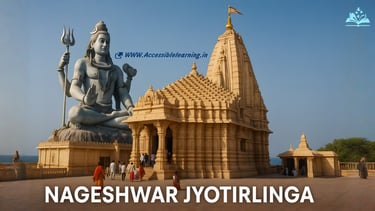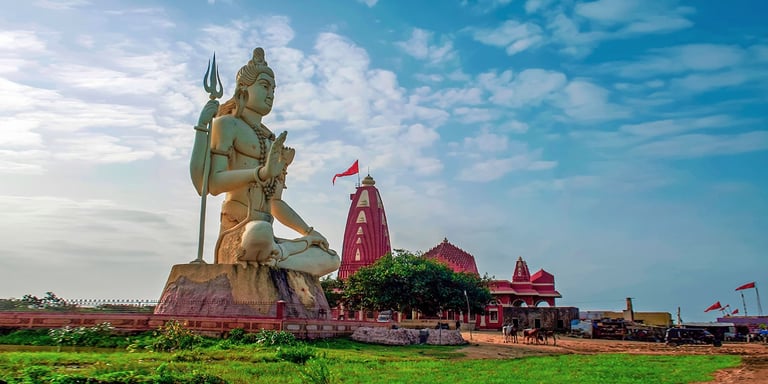
Nageshwar Jyotirlinga: A Sacred Abode of Shiv Ji!
Nestled in the serene landscape of Gujarat, India, the Nageshwar Jyotirlinga is one of the twelve Jyotirlingas, the holiest shrines dedicated to Shiv Ji. Located near the holy city of Dwarka, this iconic temple holds great significance in Hindu mythology and spiritual tradition.
TRAVEL LIFESTORY/ENTERTAINMENTINDIA/BHARAT
Sachin K Chaurasiya
7/29/20255 min read


Nestled in the serene landscape of Gujarat, India, Nageshwar Jyotirlinga (नागेश्वर ज्योतिर्लिंग) is one of the twelve Jyotirlingas, the most sacred shrines dedicated to Shiv Ji. Located near the holy city of Dwarka (द्वारका नगरम्), this revered temple holds great significance in Hindu mythology and spiritual tradition. Nageshwar Jyotirlinga symbolizes protection from all forms of evil and is a destination for devotees seeking peace and divine blessings. In this article, we will discuss in depth the history, mythology, and unique aspects of this spiritual site.
The Mythological Tale of Nageshwar Jyotirlinga
The story of Nageshwar Jyotirlinga is intertwined with ancient Hindu mythology. According to legend, a demon named Daruka, along with his wife Daruki, once terrorized the local population. Daruki was a fervent devotee of Mat Parvati Ji (माता पार्वती जी), and due to her devotion, she was blessed with a boon that allowed her to control a dense forest, which became known as Daarukavana.
Daruka, empowered by his wife’s boon (वरदान), became arrogant and began harassing devotees of Shiv Ji. Among the victims (पीड़ित) was a Shiv Ji devotee named Supriya (सुप्रिया), who was captured and imprisoned by the demon. Despite being held captive, Supriya continued to chant (मंत्र) the powerful "Om Namah Shivaya (ॐ नमः शिवाय)" mantra, invoking Shiv Ji's protection.
Moved by Supriya’s unwavering devotion, Shiv Ji appeared in the form of a Jyotirlinga and vanquished the demon Daruka. The place where this divine intervention occurred became known as Nageshwar, and it is here that the Nageshwar Jyotirlinga is enshrined.


Significance of Nageshwar Jyotirlinga
Nageshwar Jyotirlinga is not just a religious site; it is a symbol of protection, courage, and divine intervention. The temple being located in Darukavana, which was once a dense forest, adds to its mystique. Devotees believe that worshipping (पूजा) at this temple gives them the strength to overcome their fears and challenges. It is also said to protect against poison and other dangers.
The lingam at Nageshwar is unique in its appearance. Different from other jyotirlingas, the Nageshwar lingam faces south, while the gomukhi (spout / गोमुखी) faces east. This position is symbolic, signifying God's vigilance over his devotees and his readiness to protect them from any harm.
The Unique Features of Nageshwar Jyotirlinga
Lingam orientation (लिंगम अभिविन्यास): Unlike other Jyotirlingas, the Nageshwara lingam faces south and the gomukhi (spout) faces east. This orientation is believed to signify Shiv Ji's vigilant protection over his devotees, warding off negative influences and dangers.
Iconic Shiv Ji's statue (प्रतिष्ठित शिव जी की प्रतिमा): The temple complex houses an imposing 80-foot-tall statue of Shiv Ji in a sitting posture. This huge statue, with its calm expression and iconic trident, is a major attraction and can be seen from afar, adding to the majestic ambiance of the temple.
Spiritual significance (आध्यात्मिक महत्व): Devotees visit the Nageshwara Jyotirlinga to gain courage, protection, and relief from fear and anxiety. The temple is also associated with protection from poisonous creatures and other dangers, making it a place where people come to pray for safety and well-being.

Festivals and Celebrations
Maha Shivaratri (महा शिवरात्रि): Celebrated in February or March, this festival marks the night when Shiv Ji is believed to have performed the cosmic dance (ब्रह्माण्डनृत्यम्) of creation, preservation, and destruction. The temple sees a massive influx of devotees during this time, who participate in special rituals and prayers.
Shravan Maas (श्रावण मास): The month of Shravan (July–August) is dedicated to Shiv Ji. Mondays during this month are considered particularly auspicious, and devotees throng the temple to perform rituals and seek blessings.
Rudrabhishek (रुद्राभिषेक): A special ritual performed during these festivals, Rudrabhishek involves the ceremonial bathing of Shiv Ji's Lingam with water, milk, honey, and other sacred offerings, accompanied by the chanting of Vedic hymns (वैदिक मंत्रों का जाप).
Spiritual Beliefs & Rituals (आध्यात्मिक विश्वास और अनुष्ठान)
Devotees visiting Nageshwar Jyotirlinga believe that offering prayers at this shrine helps in overcoming fear (भयं), anxiety (चिन्ता), and other negative emotions (अन्ये नकारात्मकभावनाः च). The temple is also associated with protection from poisonous creatures (विषयुक्ताः प्राणिनः), and many people visit the temple to seek blessings for safety and well-being.
One of the rituals unique to Nageshwar is the offering of milk and bilva (दुग्धं बिल्वं च) leaves to the Lingam. It is believed that these offerings please Shiv Ji and help in fulfilling the wishes of the devotees. Pilgrims also perform abhisheka (ritual bathing) of the Lingam with water, milk, honey, and ghee, accompanied by the chanting of Vedic hymns (वैदिक मंत्रोच्चार के साथ जल, दूध, शहद और घी से शिवलिंग का अभिषेक किया जाता है।).


Travel Guide to Nageshwar Jyotirlinga
For those planning a pilgrimage or visit to Nageshwar Jyotirlinga, here is a comprehensive travel guide:
Location
Nageshwar Jyotirlinga is located about 17 kilometers from Dwarka in Gujarat. Dwarka is a famous pilgrimage site, famous for the Dwarkadhish Temple dedicated to Krishna Ji (द्वारकाधीश कृष्ण जी).
How to Reach
By Air: The nearest airport is Jamnagar Airport, located at a distance of about 137 km from Nageshwar. From the airport, you can take a taxi or bus to reach the temple.
By Train: The nearest railway station is Dwarka, which is well connected to major cities in India. Nageshwar can be easily reached by road from Dwarka.
By Road: Nageshwar is well connected by road to Dwarka, with regular buses and taxis available.
Best Time to Visit
The ideal time to visit Nageshwar Jyotirlinga is between October and February, when the weather is pleasant. This period is also the best time to attend the Mahashivratri festival.
Temple Timings
The temple is open from morning to late evening, with fixed aarti (prayer/प्रार्थना) timings that visitors can join for a more immersive experience.
Accommodation
Dwarka has a wide range of accommodation options, from budget hotels to more luxurious ones. It is advisable to book well in advance, especially during peak pilgrimage season.
Nearby Attractions
Dwarkadhish Temple: One of the major attractions in Dwarka is dedicated to Krishna Ji.
Bet Dwarka: A small island off the coast of Dwarka, believed to be the original home of Krishna Ji.
Rukmini Devi Temple: Dedicated to Rukmini, the wife of Krishna Ji (कृष्ण जी), located near Dwarka.
Local Cuisine
Visitors can enjoy traditional Gujarati cuisine, as many local restaurants and eateries offer a variety of vegetarian dishes. Don't forget to try local sweets like ghari and mohanthal.
Travel Tips
Dress code: Dress modestly while visiting the temple. It is advisable to avoid wearing shorts and sleeveless tops.
Photography: Photography is usually allowed outside the temple premises but may be restricted inside. Always check with the temple authorities before clicking on pictures.
Respect local customs: Follow the temple guidelines and respect local customs. Participate in rituals if you feel comfortable and maintain etiquette in the temple premises.
Nageshwar Jyotirlinga is not just a temple but a journey into the heart of India's spiritual heritage. With its rich history, powerful mythology, and serene atmosphere, it offers an intense experience for pilgrims and travelers. Whether you seek divine blessings, spiritual growth, or simply want to explore India's cultural heritage, Nageshwar Jyotirlinga is a destination you must include in your itinerary.
Subscribe To Our Newsletter
All © Copyright reserved by Accessible-Learning Hub
| Terms & Conditions
Knowledge is power. Learn with Us. 📚


